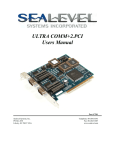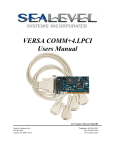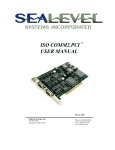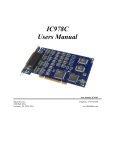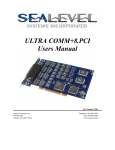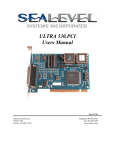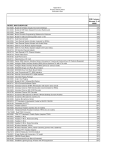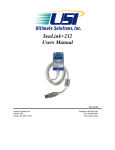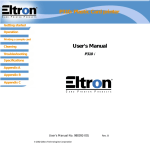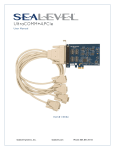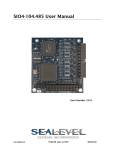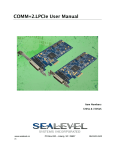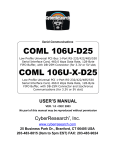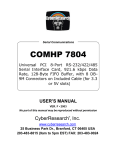Download Single Channel RS-422/485/530 Serial Interface for the PCI Bus
Transcript
User’s Guide Shop online at www.omega.com e-mail: [email protected] OMG-ULTRA-485-PCI M-4024/1203 OMEGAnet ® Online Service www.omega.com Internet e-mail [email protected] Servicing North America: USA: ISO 9001 Certified Canada: One Omega Drive, Box 4047 Stamford CT 06907-0047 Tel: (203) 359-1660 e-mail: [email protected] 976 Bergar Laval (Quebec) H7L 5A1 Tel: (514) 856-6928 e-mail: [email protected] FAX: (203) 359-7700 FAX: (514) 856-6886 For immediate technical or application assistance: USA and Canada: Sales Service: 1-800-826-6342 / 1-800-TC-OMEGA® Customer Service: 1-800-622-2378 / 1-800-622-BEST® Engineering Service: 1-800-872-9436 / 1-800-USA-WHEN® TELEX: 996404 EASYLINK: 62968934 CABLE: OMEGA Mexico: En Español: (001) 203-359-7803 FAX: (001) 203-359-7807 e-mail: [email protected] [email protected] Servicing Europe: Benelux: Postbus 8034, 1180 LA Amstelveen, The Netherlands Tel: +31 (0)20 3472121 FAX: +31 (0)20 6434643 Toll Free in Benelux: 0800 0993344 e-mail: [email protected] Czech Republic: Rude´ armády 1868, 733 01 Karvina´ 8 Tel: +420 (0)69 6311899 Toll Free: 0800-1-66342 France: FAX: +420 (0)69 6311114 e-mail: [email protected] 11, rue Jacques Cartier, 78280 Guyancourt, France Tel: +33 (0)1 61 37 29 00 FAX: +33 (0)1 30 57 54 27 Toll Free in France: 0800 466 342 e-mail: [email protected] Germany/Austria: Daimlerstrasse 26, D-75392 Deckenpfronn, Germany Tel: +49 (0)7056 9398-0 Toll Free in Germany: 0800 639 7678 e-mail: [email protected] FAX: +49 (0)7056 9398-29 United Kingdom: One Omega Drive, River Bend Technology Centre ISO 9002 Certified Northbank, Irlam, Manchester M44 5BD United Kingdom Tel: +44 (0)161 777 6611 FAX: +44 (0)161 777 6622 Toll Free in United Kingdom: 0800-488-488 e-mail: [email protected] It is the policy of OMEGA to comply with all worldwide safety and EMC/EMI regulations that apply. OMEGA is constantly pursuing certification of its products to the European New Approach Directives. OMEGA will add the CE mark to every appropriate device upon certification. The information contained in this document is believed to be correct, but OMEGA Engineering, Inc. accepts no liability for any errors it contains, and reserves the right to alter specifications without notice. WARNING: These products are not designed for use in, and should not be used for, patient-connected applications. Contents INTRODUCTION ..........................................................................................................................1 OVERVIEW ................................................................................................................................................1 WHAT’S INCLUDED ...................................................................................................................................1 CARD SETUP ..............................................................................................................................2 RS-485 ENABLE MODES ...........................................................................................................................2 CLOCK MODES ..........................................................................................................................................2 BAUD RATES AND DIVISORS FOR THE ‘DIV1’ MODE..................................................................................3 ADDRESS AND IRQ SELECTION .................................................................................................................4 LINE TERMINATION ...................................................................................................................................4 INSTALLATION ...........................................................................................................................5 OPERATING SYSTEM INSTALLATION .........................................................................................................5 WINDOWS 95/98/ME/NT/2000/XP...........................................................................................................5 LINUX .......................................................................................................................................................5 QNX .........................................................................................................................................................5 PHYSICAL INSTALLATION ..........................................................................................................................6 TECHNICAL DESCRIPTION.........................................................................................................7 CONNECTOR PIN ASSIGNMENTS ................................................................................................................7 RS-422/485/530 Pin Assignments (DB-25 Male DTE) ........................................................................7 SPECIFICATIONS ........................................................................................................................8 ENVIRONMENTAL SPECIFICATIONS ...........................................................................................................8 MANUFACTURING .....................................................................................................................................8 POWER CONSUMPTION ..............................................................................................................................8 PHYSICAL DIMENSIONS .............................................................................................................................8 APPENDIX A - TROUBLESHOOTING ...........................................................................................9 APPENDIX B - HOW TO GET ASSISTANCE ..............................................................................10 APPENDIX C - ELECTRICAL INTERFACE .................................................................................11 RS-422 ...................................................................................................................................................11 RS-485 ...................................................................................................................................................11 RS-530 ...................................................................................................................................................11 APPENDIX D - ASYNCHRONOUS COMMUNICATIONS ..............................................................12 APPENDIX E - SILK-SCREEN....................................................................................................13 APPENDIX F - COMPLIANCE NOTICES ....................................................................................14 FEDERAL COMMUNICATIONS COMMISSION STATEMENT .........................................................................14 EMC DIRECTIVE STATEMENT .................................................................................................................14 Introduction Introduction Overview The OMG-ULTRA-485-PCI is a one channel PCI Bus serial I/O adapter. It provides one field selectable RS-422/485/530 serial port supporting asynchronous data rates up to 460.8K bps. Choose the RS-422 mode for long distance device connections up to 4000ft. where noise immunity and high data integrity are essential. Select RS-485 and capture data from multiple peripherals in a RS-485 multi-drop network. Up to 31 RS-485 devices can be connected to each port to automate your data collection. In RS-485 mode, our special auto-enable feature allows the RS-485 ports to be viewed by the operating system as a COM: port. This allows the standard COM: driver to be utilized for RS-485 communications. Our on-board hardware automatically handles the RS-485 driver enable. What’s Included The OMG-ULTRA-485-PCI is shipped with the following items. If any of these items is missing or damaged, please contact Omega Engineering. • OMG-ULTRA-485-PCI Serial I/O Adapter • Software CD OMG-ULTRA-485-PCI Page 1 Card Setup Card Setup RS-485 Enable Modes RS-485 is ideal for multi-drop or network environments. RS-485 requires a tri-state driver that will allow the electrical presence of the driver to be removed from the line. The driver is in a tri-state or high impedance condition when this occurs. Only one driver may be active at a time and the other driver(s) must be tri-stated. The output modem control signal Request To Send (RTS) is typically used to control the state of the driver. Some communication software packages refer to RS-485 as RTS enable or RTS block mode transfer. One of the unique features of the OMG-ULTRA-485-PCI is the ability to be RS-485 compatible without the need for special software or drivers. This ability is especially useful in Windows and OS/2 environments where the lower level I/O control is abstracted from the application program. This ability means that the user can effectively use the OMG-ULTRA-485-PCI in an RS-485 application with existing (i.e. standard RS-232) software drivers. Switch SW2 is used to control the RS-485 mode functions for the driver circuit. The selections are: ‘Auto’ enable (silk-screen ‘AT’). The ‘Auto’ enable feature automatically enables/disables the RS-485 interface via on board circuitry. ‘RTS’ enable (silk-screen ‘RT’) The ‘RTS’ mode uses the ‘RTS’ modem control signal to enable the RS-485 interface and provides backward compatibility with existing software products. ‘No Echo’ (silk-screen ‘NE’) is used to control the RS-485 enable/disable functions for the receiver circuit and determine the state of the RS-422/485 driver. The RS-485 ‘Echo’ is the result of connecting the receiver inputs to the transmitter outputs. Every time a character is transmitted; it is also received. This can be beneficial if the software can handle echoing (i.e. using received characters to throttle the transmitter) or it can confuse the system if the software does not. To select the ‘No Echo’ mode select silk-screen position ‘NE’. Clock Modes The OMG-ULTRA-485-PCI employs a unique clocking option that allows the end user to select from divide by 4 and divide by 1 clocking modes. SW2 positions 1 and 2 select the Divide by 1 (silk-screen D1) and Divide by 4 (silk-screen D4) modes. To select the Baud rates commonly associated with COM: ports (i.e. 2400, 4800, 9600, 19.2, … 115.2K Bps ) set switch SW2 in the divide by 4 mode (silk-screen D4). To select the maximum data rate up to 460.8K bps set switch SW2 in the divide by 1 (silk-screen D1) position. Please refer to the following page for these additional data rates. Caution: Do not set both switches on or invalid clocking will occur. RS-485 Mode and Clock Mode Examples (Switch SW2) D D AR N 1 4 TT E ON OFF 1 2 3 4 5 Figure 1- Switch SW2, RS-422, Divide by 4 OMG-ULTRA-485-PCI Page 2 Card Setup D D AR N 1 4 TT E ON OFF 1 2 3 4 5 Figure 2 – Switch SW2, RS-485 ‘Auto’ Enabled, with ‘No Echo’ Divide by 4 D D AR N 1 4 TT E ON OFF 1 2 3 4 5 Figure 3 - Switch SW2, RS-485 ‘Auto’ Enabled, with ‘Echo’ Divide by 4 Baud Rates and Divisors for the ‘Div1’ mode The following table shows some common data rates and the rates you should choose to match them if using the adapter in the ‘Div1’ mode. For this Data Rate 1200 bps 2400 bps 4800 bps 9600 bps 19.2K bps 57.6 K bps 115.2 K bps 230.4K bps 460.8K bps Choose this Data Rate 300 bps 600 bps 1200 bps 2400 bps 4800 bps 14.4K bps 28.8K bps 57.6 K bps 115.2 K bps If your communications package allows the use of Baud rate divisors, choose the appropriate divisor from the following table: For this Data Rate 1200 bps 2400 bps 4800 bps 9600 bps 19.2K bps 38.4K bps 57.6K bps 115.2K bps 230.4K bps 460.8K bps OMG-ULTRA-485-PCI Choose this Divisor 384 192 96 48 24 12 8 4 2 1 Page 3 Card Setup Address and IRQ selection The OMG-ULTRA-485-PCI is automatically assigned resources by your motherboard BIOS. Only the I/O address may be modified by the user. Adding or removing other hardware may change the assignment of I/O addresses and IRQs. Line Termination Typically, each end of the RS-485 bus must have line-terminating resistors (RS-422 terminates at the receive end only). A 120-ohm resistor is across each RS-422/485 input in addition to a 1K-ohm pull-up/pull-down combination that biases the receiver inputs. Switch SW1 allows customization of this interface to specific requirements. Each switch position corresponds to a specific portion of the interface. If multiple OMG-ULTRA-485-PCI adapters are configured in an RS-485 network, only the boards on each end should have switches T, P & P ON. Refer to the following table for each position’s operation: Name T P P L L Function Adds or removes the 120 ohm termination. Adds or removes the 1K ohm pull-down resistor in the RS-422/RS-485 receiver circuit (Receive data only). Adds or removes the 1K ohm pull-up resistor in the RS-422/RS485 receiver circuit (Receive data only). Connects the TX+ to RX+ for RS-485 two-wire operation. Connects the TX- to RX- for RS-485 two-wire operation. PPTLL ON OFF 1 2 3 4 5 Figure 4 - Switch SW1, Line Termination OMG-ULTRA-485-PCI Page 4 Installation Installation Operating System Installation Windows 95/98/ME/NT/2000/XP Do not install the Adapter in the machine until the software has been fully installed. 1. Start Windows. 2. Insert the software CD in to your CD drive. 3. If ‘Auto-Start’ is enabled for this drive the software will automatically launch. Otherwise, point your browser to the ‘Index.htm’ on the root directory of the CD 4. Select ‘Install Software’. 5. Select the Part Number for your adapter from the listing. 6. Select ‘Windows 98/ME/2000/XP’. The setup file will automatically detect the operating environment and install the proper components. Next (depending on the OS version) select the ‘Run this program from its current location’ or ‘Open’ option. Follow the information presented on the screens that follow. 7. A screen may appear with the declaration: “The publisher cannot be determined due to the problems below: Authenticode signature not found.” Please select the ‘Yes’ button and proceed with the installation. This declaration simply means that the Operating System is not aware of the driver being loaded. It will not cause any harm to your system. 8. During setup the user may specify installation directories and other preferred configurations. This program also adds entries to the system registry that are necessary for specifying the operating parameters for each driver. An uninstall option is also included to remove all registry/INI file entries from the system. Linux Refer to D:\software\seacom\Other\Linux\Linux.serial.readme (where D: = your CDROM driver letter) found on the software CD. This file contains valuable information on installing your adapter in the various Linux releases. Also in this sub-directory is the Linux SerialHOWTO. This series of files explains typical Linux serial implementations, as well as informing the user to Linux syntax and preferred practices. QNX Refer to D:\software\seacom\Other\QNX6\Install.readme (where D: = your CDROM driver letter) found on the software CD. This file contains valuable information on installing your adapter in the QNX6 Neutrino OS, as well as the files required to ensure a flawless implementation. Also provided on the software CD are implementation instructions for QNX4. These are found in D:\software\seacom\Other\QNX4\QNX_COM.txt. OMG-ULTRA-485-PCI Page 5 Installation Physical Installation The adapter can be installed in any 5V PCI expansion slot and contains several jumper straps for each port that must be set for proper. Do not install the Adapter in the machine until the software has been fully installed. 1. Turn off PC power. Disconnect the power cord. 2. Remove the PC case cover. 3. Locate an available PCI slot and remove the blank metal slot cover. 4. Gently insert the PCI adapter into the slot. Make sure that the adapter is seated properly. 5. Replace the screw. (This is required to ensure FCC Part 15 compliance.) 6. Replace the cover. 7. Connect the power cord Installation is finished. OMG-ULTRA-485-PCI Page 6 Technical Description Technical Description The OMG-ULTRA-485-PCI provides an additional asynchronous serial port, field selectable as RS-422/485/530 for industrial automation and control applications. The OMG-ULTRA-485-PCI utilizes the EXAR 16C850 UART. This chip features programmable baud rates, data format, interrupt control and an industry leading 128 byte FIFOs. Connector Pin Assignments RS-422/485/530 Pin Assignments (DB-25 Male DTE) Signal GND RDB RDA CTSB CTSA TDB TDA RTSB RTSA RX+ RXCTS+ CTSTX+ TXRTS+ RTS- Name Ground Receive Positive Receive Negative Clear To Send Positive Clear To Send Negative Transmit Positive Transmit Negative Request To Send Positive Request To Send Negative Pin # 7 16 3 13 5 14 2 19 4 Mode Input Input Input Input Output Output Output Output Note: These assignments meet the EIA/TIA/ANSI-530 DTE. OMG-ULTRA-485-PCI Page 7 Specifications Specifications Environmental Specifications Specification Temperature Range Humidity Range Operating 0º to 70º C (32º to 158º F) 10 to 90% R.H. Non-Condensing Storage -50º to 105º C (-58º to 221º F) 10 to 90% R.H. Non-Condensing Manufacturing All Printed Circuit boards are built to UL 94V0 rating and are 100% electrically tested. These printed circuit boards are solder mask over bare copper or solder mask over tin nickel. Power Consumption Supply line Rating +5 VDC 480 mA Physical Dimensions Board length Board Height including Goldfingers Board Height excluding Goldfingers OMG-ULTRA-485-PCI 4.9 inches 2.80 inches 2.475 inches (12.446 cm) (7.112 cm) (6.287cm) Page 8 Appendix A - Troubleshooting Appendix A - Troubleshooting Software is supplied with the OMG-ULTRA-485-PCI adapter and may be used in the troubleshooting procedures. Using this software and following these simple steps can eliminate most common problems without the need to call Technical Support. 1. Identify all I/O adapters currently installed in your system. This includes your on-board serial ports, controller cards, sound cards etc. The I/O addresses used by these adapters, as well as the IRQ (if any) should be identified. 2. Configure your OMG-ULTRA-485-PCI adapter so that there is no conflict with currently installed adapters. No two adapters can occupy the same I/O address. 3. Make sure the OMG-ULTRA-485-PCI adapter is using a unique IRQ. While the adapter does allow the sharing of IRQs, many other adapters (i.e. SCSI adapters & on-board serial ports) do not. The IRQ is typically selected by the BIOS or Operating system. Some BIOS setup software will allow changing the IRQ, but others do not. Another method of changing assigned resources is to try changing PCI slots. This will typically cause the BIOS or OS to reassign the resources. 4. Make sure the OMG-ULTRA-485-PCI adapter is securely installed in a motherboard slot. 5. When running DOS or Windows 3.x refer to the supplied software and this User Manual to verify that the adapter is configured correctly. This software contains a diagnostic program ‘SSD’ (D:\software\seacom\Other\DOS\DIAG, where D: = the driver letter of your CDROM drive) will verify if an adapter is configured properly. This diagnostic program is written with the user in mind and is easy to use. You can use D:\software\seacom\Other\DOS\PCI\FindPCI.exe to determine resources that have been assigned to your adapter. Make sure that if available, the ‘Use Plug-n-Play” option is turned ‘OFF’ in your BIOS. Having this option set to ‘ON’ in DOS or Windows 3.x will cause erratic operations. 6. For Windows95/98/ME/NT/2000, the diagnostic tool ‘WinSSD’ is installed in the SeaCOM folder on the Start Menu during the setup process. First find the ports using the Device Manager, then use ‘WinSSD’ to verify that the ports are functional. 7. Remember that a loopback test is not possible with the ‘NE’ switch turned on. 8. Always use the diagnostic software when troubleshooting a problem. This will eliminate any software issues from the equation. - OMG-ULTRA-485-PCI Page 9 Appendix B - How To Get Assistance Appendix B - How To Get Assistance Please refer to Troubleshooting Guide prior to calling Technical Support. 1. Begin by reading through the Troublesooting Guide in Appendix A. If assistance is still needed please see below. 2. When calling for technical assistance, please have your user manual and current adapter settings. If possible, please have the adapter installed in a computer ready to run diagnostics. 3. Omega Engineering maintains a web page on the Internet. Our home page address is http://www.omega.com. The latest software updates, and newest manuals are available via our web site. 4. Technical support is available Monday to Friday from 8:30 a.m. to 6:00 p.m. eastern time. Technical support can be reached at 1-800-DAS-IEEE. Return Authorization Must Be Obtained From Omega Engineering Before Returned Merchandise Will Be Accepted. Authorization Can Be Obtained By Calling Omega Engineering Customer Service And Requesting An Authorized Return (AR) Number. OMG-ULTRA-485-PCI Page 10 Appendix C – Electrical Interface Appendix C - Electrical Interface RS-422 The RS-422 specification defines the electrical characteristics of balanced voltage digital interface circuits. RS-422 is a differential interface that defines voltage levels and driver/receiver electrical specifications. On a differential interface, logic levels are defined by the difference in voltage between a pair of outputs or inputs. In contrast, a single ended interface, for example RS-232, defines the logic levels as the difference in voltage between a single signal and a common ground connection. Differential interfaces are typically more immune to noise or voltage spikes that may occur on the communication lines. Differential interfaces also have greater drive capabilities that allow for longer cable lengths. RS-422 is rated up to 10 Megabits per second and can have cabling 4000 feet long. RS-422 also defines driver and receiver electrical characteristics that will allow 1 driver and up to 32 receivers on the line at once. RS-422 signal levels range from 0 to +5 volts. RS-422 does not define a physical connector. RS-485 RS-485 is backwardly compatible with RS-422; however, it is optimized for partyline or multi-drop applications. The output of the RS-422/485 driver is capable of being Active (enabled) or Tri-State (disabled). This capability allows multiple ports to be connected in a multi-drop bus and selectively polled. RS-485 allows cable lengths up to 4000 feet and data rates up to 10 Megabits per second. The signal levels for RS-485 are the same as those defined by RS-422. RS-485 has electrical characteristics that allow for 32 drivers and 32 receivers to be connected to one line. This interface is ideal for multi-drop or network environments. RS-485 tri-state driver (not dual-state) will allow the electrical presence of the driver to be removed from the line. Only one driver may be active at a time and the other driver(s) must be tri-stated. RS-485 can be cabled in two ways, two wire and four wire mode. Two wire mode does not allow for full duplex communication, and requires that data be transferred in only one direction at a time. For half-duplex operation, the two transmit pins should be connected to the two receive pins (Tx+ to Rx+ and Tx- to Rx-). Four wire mode allows full duplex data transfers. RS-485 does not define a connector pin-out or a set of modem control signals. RS-485 does not define a physical connector. RS-530 RS-530 (a.k.a. EIA-530) compatibility means that RS-422 signal levels are met, and the pin-out for the DB-25 connector is specified. The EIA (Electronic Industry Association) created the RS-530 specification to detail the pin-out, and define a full set of modem control signals that can be used for regulating flow control and line status. The RS-530 specification defines two types of interface circuits, Data Terminal Equipment (DTE) and Data CircuitTerminating Equipment (DCE). The OMG-ULTRA-485-PCI adapter is a DTE interface. OMG-ULTRA-485-PCI Page 11 Appendix D - Asynchronous Communications Appendix D - Asynchronous Communications Serial data communications implies that individual bits of a character are transmitted consecutively to a receiver that assembles the bits back into a character. Data rate, error checking, handshaking, and character framing (start/stop bits) are pre-defined and must correspond at both the transmitting and receiving ends. Asynchronous communications is the standard means of serial data communication for PC compatibles and PS/2 computers. The original PC was equipped with a communication or COM: port that was designed around an 8250 Universal Asynchronous Receiver Transmitter (UART). This device allows asynchronous serial data to be transferred through a simple and straightforward programming interface. A start bit, followed by a pre-defined number of data bits (5, 6, 7, or 8) defines character boundaries for asynchronous communications. The end of the character is defined by the transmission of a pre-defined number of stop bits (usually 1, 1.5 or 2). An extra bit used for error detection is often appended before the stop bits. Idle state of line 5 to 8 Data Bits Odd, Even or Unused Remain Idle or next start bit 1 P BIT STOP 0 1 1.5 2 Figure 5 - Asynchronous Communications Bit Diagram This special bit is called the parity bit. Parity is a simple method of determining if a data bit has been lost or corrupted during transmission. There are several methods for implementing a parity check to guard against data corruption. Common methods are called (E)ven Parity or (O)dd Parity. Sometimes parity is not used to detect errors on the data stream. This is refereed to as (N)o parity. Because each bit in asynchronous communications is sent consecutively, it is easy to generalize asynchronous communications by stating that each character is wrapped (framed) by pre-defined bits to mark the beginning and end of the serial transmission of the character. The data rate and communication parameters for asynchronous communications have to be the same at both the transmitting and receiving ends. The communication parameters are baud rate, parity, number of data bits per character, and stop bits (i.e. 9600, N, 8, 1). OMG-ULTRA-485-PCI Page 12 Appendix E - Silk-Screen Appendix E - Silk-Screen 2.8" 4.9" OMG-ULTRA-485-PCI Page 13 Appendix F- Compliance Notices Appendix F - Compliance Notices Federal Communications Commission Statement FCC - This equipment has been tested and found to comply with the limits for Class A digital device, pursuant to Part 15 of the FCC Rules. These limits are designed to provide reasonable protection against harmful interference when the equipment is operated in a commercial environment. This equipment generates, uses, and can radiate radio frequency energy and, if not installed and used in accordance with the instruction manual, may cause harmful interference to radio communications. Operation of this equipment in a residential area is likely to cause harmful interference in such case the user will be required to correct the interference at the users expense. EMC Directive Statement Products bearing the CE Label fulfill the requirements of the EMC directive (89/336/EEC) and of the low-voltage directive (73/23/EEC) issued by the European Commission. To obey these directives, the following European standards must be met: EN55022 Class A - “Limits and methods of measurement of radio interference characteristics of information technology equipment” EN55024 – “Information technology equipment Immunity characteristics Limits and methods of measurement”. EN60950 (IEC950) - “Safety of information technology equipment, including electrical business equipment” Warning This is a Class A Product. In a domestic environment, this product may cause radio interference in which case the user may be required to take adequate measures to prevent or correct the interference. Always use cabling provided with this product if possible. If no cable is provided or if an alternate cable is required, use high quality shielded cabling to maintain compliance with FCC/EMC directives. OMG-ULTRA-485-PCI Page 14 WARRANTY/DISCLAIMER OMEGA ENGINEERING, INC. warrants this unit to be free of defects in materials and workmanship for a period of 13 months from date of purchase. OMEGA’s Warranty adds an additional one (1) month grace period to the normal one (1) year product warranty to cover handling and shipping time. This ensures that OMEGA’s customers receive maximum coverage on each product. If the unit malfunctions, it must be returned to the factory for evaluation. OMEGA’s Customer Service Department will issue an Authorized Return (AR) number immediately upon phone or written request. Upon examination by OMEGA, if the unit is found to be defective, it will be repaired or replaced at no charge. OMEGA’s WARRANTY does not apply to defects resulting from any action of the purchaser, including but not limited to mishandling, improper interfacing, operation outside of design limits, improper repair, or unauthorized modification. This WARRANTY is VOID if the unit shows evidence of having been tampered with or shows evidence of having been damaged as a result of excessive corrosion; or current, heat, moisture or vibration; improper specification; misapplication; misuse or other operating conditions outside of OMEGA’s control. Components which wear are not warranted, including but not limited to contact points, fuses, and triacs. OMEGA is pleased to offer suggestions on the use of its various products. However, OMEGA neither assumes responsibility for any omissions or errors nor assumes liability for any damages that result from the use of its products in accordance with information provided by OMEGA, either verbal or written. OMEGA warrants only that the parts manufactured by it will be as specified and free of defects. OMEGA MAKES NO OTHER WARRANTIES OR REPRESENTATIONS OF ANY KIND WHATSOEVER, EXPRESS OR IMPLIED, EXCEPT THAT OF TITLE, AND ALL IMPLIED WARRANTIES INCLUDING ANY WARRANTY OF MERCHANTABILITY AND FITNESS FOR A PARTICULAR PURPOSE ARE HEREBY DISCLAIMED. LIMITATION OF LIABILITY: The remedies of purchaser set forth herein are exclusive, and the total liability of OMEGA with respect to this order, whether based on contract, warranty, negligence, indemnification, strict liability or otherwise, shall not exceed the purchase price of the component upon which liability is based. In no event shall OMEGA be liable for consequential, incidental or special damages. CONDITIONS: Equipment sold by OMEGA is not intended to be used, nor shall it be used: (1) as a “Basic Component” under 10 CFR 21 (NRC), used in or with any nuclear installation or activity; or (2) in medical applications or used on humans. Should any Product(s) be used in or with any nuclear installation or activity, medical application, used on humans, or misused in any way, OMEGA assumes no responsibility as set forth in our basic WARRANTY/DISCLAIMER language, and, additionally, purchaser will indemnify OMEGA and hold OMEGA harmless from any liability or damage whatsoever arising out of the use of the Product(s) in such a manner. RETURN REQUESTS/INQUIRIES Direct all warranty and repair requests/inquiries to the OMEGA Customer Service Department. BEFORE RETURNING ANY PRODUCT(S) TO OMEGA, PURCHASER MUST OBTAIN AN AUTHORIZED RETURN (AR) NUMBER FROM OMEGA’S CUSTOMER SERVICE DEPARTMENT (IN ORDER TO AVOID PROCESSING DELAYS). The assigned AR number should then be marked on the outside of the return package and on any correspondence. The purchaser is responsible for shipping charges, freight, insurance and proper packaging to prevent breakage in transit. FOR WARRANTY RETURNS, please have the following information available BEFORE contacting OMEGA: 1. Purchase Order number under which the product was PURCHASED, 2. Model and serial number of the product under warranty, and 3. Repair instructions and/or specific problems relative to the product. FOR NON-WARRANTY REPAIRS, consult OMEGA for current repair charges. Have the following information available BEFORE contacting OMEGA: 1. Purchase Order number to cover the COST of the repair, 2. Model and serial number of the product, and 3. Repair instructions and/or specific problems relative to the product. OMEGA’s policy is to make running changes, not model changes, whenever an improvement is possible. This affords our customers the latest in technology and engineering. OMEGA is a registered trademark of OMEGA ENGINEERING, INC. © Copyright 2002 OMEGA ENGINEERING, INC. All rights reserved. This document may not be copied, photocopied, reproduced, translated, or reduced to any electronic medium or machine-readable form, in whole or in part, without the prior written consent of OMEGA ENGINEERING, INC. Where Do I Find Everything I Need for Process Measurement and Control? OMEGA…Of Course! Shop online at www.omega.com TEMPERATURE Thermocouple, RTD & Thermistor Probes, Connectors, Panels & Assemblies Wire: Thermocouple, RTD & Thermistor Calibrators & Ice Point References Recorders, Controllers & Process Monitors Infrared Pyrometers PRESSURE, STRAIN AND FORCE Transducers & Strain Gages Load Cells & Pressure Gages Displacement Transducers Instrumentation & Accessories FLOW/LEVEL Rotameters, Gas Mass Flowmeters & Flow Computers Air Velocity Indicators Turbine/Paddlewheel Systems Totalizers & Batch Controllers pH/CONDUCTIVITY pH Electrodes, Testers & Accessories Benchtop/Laboratory Meters Controllers, Calibrators, Simulators & Pumps Industrial pH & Conductivity Equipment DATA ACQUISITION Data Acquisition & Engineering Software Communications-Based Acquisition Systems Plug-in Cards for Apple, IBM & Compatibles Datalogging Systems Recorders, Printers & Plotters HEATERS Heating Cable Cartridge & Strip Heaters Immersion & Band Heaters Flexible Heaters Laboratory Heaters ENVIRONMENTAL MONITORING AND CONTROL Metering & Control Instrumentation Refractometers Pumps & Tubing Air, Soil & Water Monitors Industrial Water & Wastewater Treatment pH, Conductivity & Dissolved Oxygen Instruments M4024/1203





















